ShodhKosh: Journal of Visual and Performing ArtsISSN (Online): 2582-7472
|
|
Evolution of Belts from Bronze Age to Modern Fashion Statements
Allu Poshitha Rajeswari 1![]()
![]() ,
S Greeshma 2
,
S Greeshma 2![]()
![]()
1 Bachelor
Student, Department of Fashion Design, School of Arts and Design, Woxsen University, Hyderabad, Telangana, India
2 Research
Scholar, Department of Fashion Design, School of Arts and Design, Woxsen University, Hyderabad, Telangana, India
|
|
ABSTRACT |
||
|
Across history, belts have evolved
from their practical beginnings to become potent emblems of prestige, style,
and cultural expression. Belts have come a long way from their utilitarian
origins as instruments for carrying weapons in the Stone Age to their current
position as opulent fashion accessories. The historical development of belts
is examined in this essay, along with their functions in prehistoric times,
the Middle Ages, the Renaissance, and the Modern Era. It explores the social
significance of belts, how their form and function have evolved, and how they
have continued to impact fashion trends. The study also addresses future
directions and present trends in belt design, including technical
advancements, cultural influences, and sustainability initiatives. By use of
a historical context and current development analysis, this paper delves into
the history of belts and its future trends and advancements. |
|||
|
Received 08 April 2024 Accepted 06 June 2024 Published 01 July 2024 Corresponding Author S
Greeshma, greeshma2551997@gmail.com
DOI 10.29121/shodhkosh.v5.i2.2024.1072 Funding: This research
received no specific grant from any funding agency in the public, commercial,
or not-for-profit sectors. Copyright: © 2024 The
Author(s). This work is licensed under a Creative Commons
Attribution 4.0 International License. With the
license CC-BY, authors retain the copyright, allowing anyone to download,
reuse, re-print, modify, distribute, and/or copy their contribution. The work
must be properly attributed to its author.
|
|||
|
Keywords: Belts, History, Trends, Advancements |
|||
1. INTRODUCTION
For millennia, belts have fulfilled the practical demands of different cultures across the globe by taking on a variety of responsibilities. Male belts have a lengthy history and were first used to carry tools or weapons during the Bronze Age. They were still useful throughout the 19th century, especially when it came to officers' clothes. Belts were fashionable accessories as the mid-19th century drew near when trouser waistlines dropped and belt loops were added. Belts have been used for a variety of reasons throughout history and in different cultures. Their main purpose in prehistoric society was utilitarian—they served as instruments for carrying weapons. Belts have their origins in military girdle bands, which were fastened around the waist to secure weapons. The historical journey of belts, from vital tools in ancient times to fashion statements, is captivating. Crafted from materials like plant fibers and animal hides, belts served as indispensable tools. Leather belts, flexible and durable, became favored in the Greek and Roman military, offering tactical advantages.
Beyond the military, belts evolved into common accessories during the European Middle Ages, symbolizing social status in the Renaissance. Despite trouser style changes, belts persisted as decorative items. Belt buckles evolved from simple to ornate designs, signifying wealth and status in ancient civilizations and the Middle Ages Fitzsimmons (2018).
The Industrial Revolution facilitated mass production, making belts and buckles accessible. In the 20th century, unique buckle designs symbolizing allegiance emerged in subcultures. Belts retained their symbolic ties to weaponry, cinching soldiers' waistlines in the 19th and 20th centuries. Utility belts, born from wartime needs, influenced post-war civilian fashion. The standardized leather belt with a metal buckle emerged in the 20th century, offering practicality and personal expression. This enduring design remains a global wardrobe staple. The Western aesthetic, seen in cowboy belts, influenced popular culture, symbolizing durability and functionality.
In contemporary times, belts have transcended utilitarian origins, entering high fashion. Luxury brands like Gucci and Hermes elevated belts, transforming them into status symbols with iconic buckles and logos. From mere waist fasteners, belts now signify both status and style, highlighting their enduring evolution Roper (2024), Harrison (2023), V (2023), Tonywell. (2023).
Figure 1

|
Figure 1 Source wikimedia.org |
2. ANCIENT BELTS: FROM PRACTICALITY TO SYMBOLISM
Belts have been used since ancient times when they served utilitarian functions like carrying tools or holding up garments. The earliest belts were discovered to be worn by humans throughout the Bronze Age, usually in Europe and some regions of Asia. They were constructed from leather, cloth, and occasionally metal, and some of the belts had ornate buckles or diamonds as decorative accents. Belts served as symbols of status and position in many ancient societies, including Egypt, Mesopotamia, and Rome. In addition to marking the positions of troops and officers, several belts were useful for carrying weapons and other necessities. Belts saw a change during the Middle Ages, becoming more symbolic. The symbol of aristocracy, knights, wore elaborate belts made of diamonds and valuable metals. The modest leather belts worn by priests and monks, which symbolized their vows, are proof that belts in religious contexts stood for virginity and purity. This timeless piece of jewelry remains a concrete connection to our shared history because of its intricate historical significance. Belts, dating back to the Bronze Age (3300-1200 BCE), were initially fashioned from plant fibers or animal hides, serving the dual purpose of securing garments and enhancing fashion. Over time, these utilitarian accessories evolved into potent symbols of power, prestige, and social identity, mirroring the shifting dynamics of human history Fitzsimmons (2018), Popoff (2023).
In ancient societies such as Egypt and Rome, belts fulfilled both utilitarian and symbolic functions. In ancient Egypt, belts made of leather, linen, and gold were used to complement their simple linen clothes and also they added beads, gems, leatherwork, and woven decorations to their belts and aprons. The jewelry used by the Egyptian nobility included hair beads, belts, necklaces, amulets, pendants, and bracelets. Emerald and pearl were the most popular gemstones. Belt use became more than just a practical accessory; it became a means of expressing individuality and social standing Joe (2022).
In ancient Rome, belts were worn by soldiers to hold their weapons and equipment, and they were also used to indicate rank and status. Until the third century AD, the Roman military belt was referred to as the balteus; after that, it was called the cingulum militare. The belt was perhaps the most important symbol of a Roman soldier, distinguishing him from civilians when he was not wearing arms and armor. The belt was used more as a mark of status (rank) than as armor (defensive use) Harrsch (2021).
3. MEDIEVAL AND RENAISSANCE BELTS: ORNATE AND FUNCTIONAL
Belts in the Middle Ages held both practical and symbolic significance, being donned by individuals of both genders. Originally, men utilized belts predominantly to secure loose overgarments and bear arms, while women later adopted them for practical purposes such as carrying purses and fans. For the latter, belts also served to tighten loose overgarments and elevate long skirts above the ground. The choice of belts varied based on social status, with affluent women opting for leather or metal belts adorned with intricate decorations.
Medieval belts assumed a symbolic role, acting as indicators of wealth and marital status for women. Wealthy women further accentuated their social standing by sporting ornate metal or leather belts, while fabric belts were less prevalent. The symbolic role extended to childbirth, where women employed birthing belts, also known as girdles, to safeguard themselves and their infants during labor.
Figure 2

|
Figure 2 Girdle Belt Source https://garystockbridge617.getarchive.net/amp/media/girdle-belt-c0d8aa |
The function of belts in the Middle Ages transcended mere practicality; they embodied societal hierarchies and became indispensable accessories for both men and women. Men's belts served as functional tools for daily tasks, reflecting their utilitarian nature, while women embraced belts for both practical and symbolic purposes, intertwining functionality with societal roles and status. In essence, belts in the Middle Ages encapsulated a fusion of practical utility and symbolic representation, contributing to the rich tapestry of medieval fashion and social expression Simmons (2020).
Belts became complex accessories embellished with metals and precious stones during the Renaissance. These belts were elaborately decorated with ornate buckles, engravings, and insignias that conveyed the wearer's position and sense of fashion. Dressing in lightweight tunics, women embraced belts as stylish accessories. As a mark of honor given to knights and rulers during the Middle Ages, belts acquired symbolic meaning. Equine themes adorned elaborately crafted buckles, keeping them useful for armaments. Production of leather items, such as belts, changed dramatically throughout the Industrial Revolution in the 19th century. From its original utilitarian use to elaborate decorations representing fashion, class, and social shifts, belts have evolved.
The development of belts throughout the Renaissance reflected the time's emphasis on extravagance and creative expression. Wide leather belts were essential pieces of clothing, adding beauty to ensembles while also tightening the waist. During the Renaissance, fashionable apparel became less functional and more artistic, emphasizing social status and riches. Methods for adding decorative components to leather belts surfaced, which corresponded with the larger shift in fashion towards individualism, extravagance, and creativity. Rich materials that were used extensively in apparel, such as silk, velvet, and brocade, had an impact on belt design, emphasizing wealth. Belts' function in the fashion world changed during the Renaissance, from simple accessories to important components of artistic and prestige displays Popoff (2023).
4. INDUSTRIAL REVOLUTION AND MODERN ERA: THE RISE OF FASHION BELTS
Belt manufacturing underwent significant change throughout the Industrial Revolution, which was a game-changing period in history. Leather belts were more widely accessible to the general population with the introduction of mass production processes. Belts underwent yet another revolution during this time with the invention of the buckle, which improved their adjustability and use. A major change in the function of belts occurred when they went from being a luxury item owned by the wealthy to a useful accessory for the working class.
Belts evolved from simple functional items to fashion statements as mass manufacturing made them more widely available. Belts became an indispensable part of fashion as a result of this shift, which accelerated in the 20th century with the surge of consumer culture. Belts gained popularity as adaptable accessories as a result of designers' experiments with different materials, styles, and embellishments as the fashion industry developed. The progression of belt-making techniques mirrors this journey, moving from conventional leatherworking techniques to contemporary ones like injection molding, die cutting, and 3D printing. The market now offers a wide variety of belts, from dressy to athletic, classic to braided, and made of materials ranging from imitation leather to exotic leather. Belts' evolution from utilitarian tools to statement fashion pieces is reflected in their history, which also reflects broader shifts in society Macks BeltsTM. (2023).
In the 20th century, belts evolved to reflect the era's focus on individualism, practicality, and creative expression in fashion. Diversification occurred, introducing materials like nylon, suede, and aluminum.
1920s - The Bold 1920s Reveal Ornamental Belts:
From being useful tools to stylish adornment, belts have evolved. They are
constructed of the same material as gowns in the 1920s when low-waisted belts
that are loose became fashionable. Belts with metal chain medallions become
popular between 1922 and 1944.
1930s - Waistlines Are Accentuated by Belts: In the
1930s, belts were a staple accessory for practically every garment, drawing
attention to the new waist over the naval. Belt widths are typically narrow and
coincide with the dress fabric. Ornate buckles designed for formal attire
incorporate antique plastics, glass, brass, silver, and paste.
1940s - Slim Cinch Belts and Utilitarian Styles:
Using substitutes like Petersham ribbon, belts become
more functional during World War II. Emerging fashions include the lace front
belt and corselette. The shirred belt gives way to the introduction of the
Cinch belt. Teenagers are starting to wear female' braces, and skinny belts are
coexisting.
1950s - Fashion Is Ruled by Cinch Belts: In the
1950s, wider belts—which now measure from 2 to 5 inches—became the standard.
Claire McCardell's design, the cinch belt, wins out because it's both stylish
and reasonably priced. Dresses look great with belts in matching or contrasting
colours and square buckles. The mid-50s are identified by cummerbund, bejeweled, and sash belts.
1960s - A Decade of Changes in Waistlines: Waistlines sagged in the 1960s, bringing attention to fashionable metal belts such as bikini chain belts. The usage of suede and leather was continued with gauntlet belts and big buckles that had a southwestern or Spanish feel. Medium-sized, neutral-colored leather belts with matching metal buckles were popular by the 1990s, marking a century-long shift in fashion towards individualism and artistic expression Sessions (2016), Wagner (2020).
5. THE FUTURE OF BELTS: TRENDS AND INNOVATIONS
5.1. Current and future trends in belt fashion include
1)
Design
for sustainability: belts
made from repurposed or recycled materials are becoming more and more
fashionable as they leave less of an environmental impact.
2)
Tech-infused
belts: Combining
fashionable elements like smart buckles that integrate with fitness apps with
health tracking capabilities.
3)
Innovative
buckle tech:
State-of-the-art designs with distinct visual appeal and practicality.
4)
Cultural
inspirations: Belts with
traditional motifs and ethnic patterns from many cultural backgrounds.
5)
High-tech
modifications: Intelligent
gadgets and modifiable elements augment belt convenience and usefulness.
6)
Exquisite
craftsmanship: Fashion
connoisseurs seek out designer belts with elaborate designs and superior
materials.
7)
Subversive
trends: Bold and sardonic
fashion statements created by belts worn as unorthodox tops or corsets Clowrey (2024).
These styles
demonstrate how accessories have evolved in fashion so that they now operate as
both practical objects and stylistic statements. They highlight the industry's
commitment to sustainability and inventiveness while reflecting the shifting
preferences of style-forward people.
Technological
advancements, sustainability goals, and continuous fashion adjustments appear
to be driving the direction of belt design and functionality in the future.
Anticipated developments could bring in adjustable comforts and smart
functions. Eco-friendly products and methods raise awareness of sustainability.
Belt styles will be shaped by fashion trends, which will include cultural
influences and retro allusions. Furthermore, developments in the automobile
belt industry indicate a coordinated strategy for improved functionality and
design. To put it simply, the future is a blend of sustainability, style, and
practicality that will accommodate personal style preferences through
technological advancements.
Sustainable and
eco-friendly techniques in the creation of fashion belts include a range of
measures aimed at reducing the negative effects on the environment and
fostering ethical production. Important procedures consist of:
1)
Materials: Using a variety of eco-friendly and
renewable materials instead of conventional leather and synthetic fabrics, such
as recycled nylon, polyester, cork, and plant-based substitutes like pineapple
leaves and apple peels.
2)
Ethical
Sourcing: Making sure that
materials are sourced ethically includes things like employing leather that is
left over from the livestock sector and putting fair labor
policies in place throughout the supply chain.
3)
Reduced
Waste: Using sustainable
packaging to lessen the environmental effect, maximizing material usage, and
streamlining design and production procedures to reduce waste.
4)
Transparency:
Ensuring that products are
made with sustainability and respect for the environment in mind by being open
and honest with customers about the materials and manufacturing processes.
5)
Longevity
Over Fast Fashion:
Promoting the creation of classic, long-lasting pieces while discouraging the
use of disposable fashion products that add to waste.
6)
Vegetable
Tanning: By using leather
that has been vegetable-tanned rather than conventionally chrome-tanned,
pollution is decreased and clients receive a safer
product.
The industry-wide
dedication to ethical manufacturing standards and environmental responsibility
is reflected in these sustainable practices.
5.2. Latest Trends in Types of Belts for Men, Women, and Children
The newest styles
and tastes are catered to with a broad range of belts for men, women, and kids.
5.2.1. Men’s Belts
1)
Leather Belts: With a variety of hues, textures, and patterns, leather belts are still
in style because they are classic and adaptable. They provide timeless elegance
for every ensemble, whether they are simple and subtle or intricate and
detailed. Textured leather belts with faded finishes, woven patterns, and
embossed designs are becoming more and more fashionable. They elevate even the
most basic clothing by giving it depth and texture and creating a subtle yet
powerful statement Clowrey (2023).
2)
Dress
Belts: Dress belts, crafted
from premium full-grain leather, exude sophistication. They seamlessly align
with dress trousers, securing your shirt and complementing your color palette. Pair with formal attire like suits or
tuxedos, coordinating with footwear for a refined look.
3)
Suede belts: Suede belts elevate business-casual or
casual ensembles with their distinct texture and gentler hues. For a chic yet
relaxed style, team them with chinos, corduroy trousers and a jacket or
button-down shirt.
Figure 3

|
Figure 3 Source www.pickpik.com |
4)
Reversible Belts: Reversible belts offer
versatility with dual colors or textures, ideal for
men seeking varied options without multiple belts. Flip to match any outfit,
from casual to formal, enhancing your color scheme
effortlessly.
Figure 4

|
Figure 4 Source https://baccabucci.com |
5)
Double Prong belts: Double-prong belts look good in both formal and informal settings. They
include two-pronged buckles for increased support and flair. They can be used
with dress pants or jeans and provide visual interest because they are made of
durable materials.
Figure 5
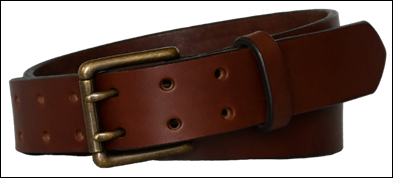
|
Figure 5 Source americanbenchcraft.com |
6)
Canvas or web belts: Belts made of canvas or web, modelled after
military gear, have a rough, everyday appeal. They're ideal for work, play, or
casual wear because they're made of sturdy woven fabrics like cotton or nylon.
These strong, adjustable belts look great with shorts, cargo pants or jeans,
showcasing their adaptability and durability.
7)
D ring belts: D-ring belts go well
with sporty or casual attire because of their distinctive buckle. Crafted from
canvas or other lightweight materials, they look great with sneakers, casual
pants, khakis and cargo shorts for a laid-back vibe.
8)
Woven belts: Elastic materials used to create woven belts
provide comfort and a unique style that makes them ideal for informal pairing
with trousers or shorts.
Figure 6
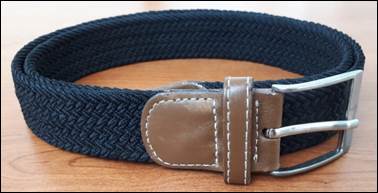
|
Figure 6 Source wikimedia.org |
9)
Braided belts: Braided belts improve the look with its
unique texture, made from leather, nylon, rayon, or waxed cotton. They add a
textural dimension to casual and sporty ensembles with their elasticity and
flexibility. They are ideal for relaxed weekends or vacations, looking great
with shorts, jeans or casual pants. Finery leather belts with braids add sophistication;
they look great with slacks, slim jeans, or loafers.
10) Ribbon inlay belts: Ribbon inlay belts, which are frequently seen in preppy or sailor
fashions with beautiful patterns, provide colour and individuality. They give a
fun, coordinated element to casual wear, and look great paired with chinos,
polo shirts, or casual blazers.
11) Ratchet
belts: Ratchet belts, with their clicking function,
offer modern, accurate fittings. Comfortably adjustable, they go well with
formal and informal attire in a variety of fabrics and designs. Innovative
additions to any wardrobe, they are both sleek and practical.
Figure 7
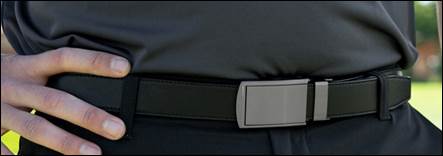
|
Figure 7 Source Slidebelts.com |
12) Snap
Belts: Snap belts provide customization for
different ensembles or events with their interchangeable buckles secured by
snap fasteners. Constructed from robust materials such as leather, they offer
both utility and customization. Ideal for everyday wear, men can switch up
the buckles for a different style.
13) western
belts: Western belts convey a rugged flair
associated with cowboy or southwestern themes, with their elaborate buckles and
decorations. They finish the look best when worn with jeans, boots, and
western-inspired clothing; for thematic coherence, wear them, especially with
cowboy boots and a hat that matches Types of Belts Decoded: A Fusion
of Style & Purpose. The Fashionisto. (2023).
5.2.2. Women's Belts
1)
Corset Belts: A modern tribute to the Victorian era, corset belts combine drama and
flair, drawing attention to the waist and enhancing refinement. Their allure
elevates any ensemble, be it baggy shirts or tight dresses.
Figure 8
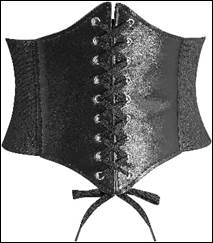
|
Figure 8 Source ubuy.co.in |
2)
Wide
Belts: Versatile and
striking, wide belts accentuate and define the waist and give a looser clothing
structure. Ideal for playing with silhouettes, they add a dramatic, glitzy
accent to minimalist ensembles.
3)
Printed
Belts: Printed belts add color to monochrome ensembles with their vivid floral and
abstract designs. Leopard and zebra prints, among other animal prints, are very
popular right now and give a bold, individual touch to any outfit.
Figure 9
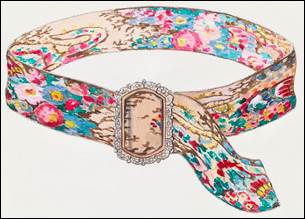
|
Figure 9 Source rawpixel.com |
4)
Chain
Belts: Chain belts are
elegant and classic, with flowing metal links that exude effortless charm.
Their glossy sheen accentuates natural curves and adds elegance to any
ensemble, flowing elegantly about the waist Trending Waist Belts to Keep an Eye on in 2024 & How
to Style Them. Nolabels.in. (2024).
Figure 10

|
Figure 10 Source publicdomainpictures.net |
6. CONTEMPORARY TRENDS AND SIGNIFICANCE OF BELTS
Belts have
returned as a flexible item in recent fashion trends, drawing attention to the
waist and taking clothing above and beyond its practicality. The present belt
fashion scene consists of:
1)
Statement
Belts: Easily elevating
basic ensembles, these belts make a dramatic fashion statement with their
eye-catching designs in an array of colours, patterns, and styles.
2)
Techwear Belts: Adapting to a range of preferences and requirements, these belts combine
fashion and function with a variety of buckle alternatives, strong fabrics,
adjustable straps, and even built-in pouches for extra utility.
3)
Minimalist
Belts: These belts, which
embrace elegance and simplicity, have sleek silhouettes, clean lines, and
high-quality materials. They enhance rather than draw attention away from
clothes.
4) Vintage Revivals: These belts combine style and cultural depth by fusing traditional themes and workmanship with premium leather, sturdy canvas, and eco-friendly fabric constructions. They radiate everlasting appeal Clowrey (2024), Clowrey (2024b).
Among the newest fashion trends, belts have evolved from simple useful objects to indispensable fashion pieces. These days, they represent a wide range of tastes and trends and are used to both fasten garments and construct statement design pieces. The fashion belt market is a vibrant industry that includes retail, distribution, production, and design. Nowadays, belts are essential clothing pieces that come in a variety of styles to suit individual tastes. Particularly well-liked are statement belts with eye-catching buckles, like those with sculptural or etched patterns, which may dress up casual clothing and lend refinement to them.
The significance
of belts has increased dramatically thanks to fashion aficionados and
influencers. They show off their impact and versatility by wearing statement
belts with their ensembles. These trendsetters have a particular fondness for
belts with silver metal, studs, snakeskin patterns, and oversized buckles. Furthermore, belts define an outfit's overall
style by their design and material selection, which express the wearer's
individuality. The increasing demand for environmentally conscious fashion is
in line with the increase of sustainable materials and eco-friendly production
in belt manufacture. This trend emphasises belts' adaptability as well as their
potential for creativity and coordination with larger fashion trends.
7. CONCLUSION
Changes in fashion, technology, and society at large are reflected in the way belts have evolved. Belts have remained adaptive and versatile throughout history, from their use as utilitarian tools in ancient civilizations to their current role as iconic fashion accessories. Belts are still changing now because of things like technology integration, sustainability, and cultural inspiration. Belts are essential for conveying personal style choices and expressing broader cultural values as fashion grows more inclusive and diverse. As we look to the future, belts are expected to combine innovation and history while emphasizing personal expression, functionality, and sustainability. The fashion industry can maintain its hold on belts' classic charm and endless variety in the years to come by adopting these trends and remaining aware of changing consumer tastes.
CONFLICT OF INTERESTS
None.
ACKNOWLEDGMENTS
None.
REFERENCES
Clowrey, J. (2023, May 13). Leather Belt Trends for Men: What’s in and What’s Out. Buckle My Belt.
Clowrey, J. (Ed.). (2024, January 11). The Ultimate Guide to 2024’s Belt Trends. Buckle My Belt.
Clowrey, J. (Ed.). (2024b, January 16). Minimalist Magic: Simplistic Belt Trends for 2024. Buckle My Belt.
Fitzsimmons, K. (2018, August 16). The History of Belts. JooJoobs.
Harrison, P. (2023a, November 23). The History of Belts: A Journey Through Fashion. Snag US.
Harrsch, M. (2021, August 2). Roman Military Belts: Symbols of Social Status and Auctoritas. Roman Military Belts: Symbols of Social Status and Auctoritas.
Joe, J. (2022, March 29). What did Pharaoh Wear: Ancient Egyptian Pharaoh’s Clothing. Timeless Myths.
Macks BeltsTM. (2023, September 17). The History of Leather Belts: From Utility to Fashion Statement. Macks BeltsTM.
Popoff, R. (2023, October 25). The Timeless Fashion of Leather Belts in Costumes and Uniforms: An Era Overview. Popov Leather®.
Roper, K. (2024, January 10). Strapping into the History of Belts. Heddels.
Sessions, D. L. (2016, November 23). A History of Belts 1920-1960 for Women. Vintage Dancer.
Simmons, A. (2020, March 15). All About (Medieval) Belts. Handmade Revolution.
Tonywell. (2023, June 21). The History of Men’S Belts: From Function to Fashion.
Trending Waist Belts to Keep an Eye on in 2024 & How to Style Them. Nolabels.in. (2024, March 8).
Types of Belts Decoded: A Fusion of Style & Purpose. The Fashionisto. (2023, December 23).
V, K. (2023, June 7). The History of Belts: From Ancient Times to Modern Fashion. Swole Panda.
Wagner, A. (2020, August 25). Evolution of a Belt. Kore Essentials.
|
|
 This work is licensed under a: Creative Commons Attribution 4.0 International License
This work is licensed under a: Creative Commons Attribution 4.0 International License
© ShodhKosh 2024. All Rights Reserved.

